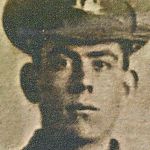Private 6/5566, 1st/6th Bn, Durham Light Infantry
Died 23rd November 1916, aged 19
Remembered at St. Sever Cemetery Extension, Rouen
Blakeney Churchyard and on both War Memorials
William was born in Blakeney 4th March 1897, the eldest son of James Edward William Seales and his wife Edith Maria Eggleton. His parents were born in Morston 1871 and Blakeney 1874, respectively and married in Blakeney 1896 at which time James gave his occupation as labourer. He was later to become a seaman and eventually retired as chief engineer with Rix and Sons of Hull.
James and Edith had 6 children; William Edward, Charles Barnabas (1899-1922), Gladys Mabel, Edith Doreen, Robert James and Herbert Walter, all born in Blakeney. Their names were provided by his mother before the Local Justice of the Peace, Charles Temple Lynes, 14th July 1919.
The 1911 Census shows that William was living with his aunt, Susan Dack, formerly Anthony nee Eggleton at Greencroft and that his occupation was ‘Farm Boy General’. His aunt Susan was his maternal grandfather’s sister and therefore, more correctly, his great aunt.
He enlisted in Norwich, 22nd November 1915 with the Norfolks as Private 5381 before transferring to the 1st/6th Durham Light Infantry sometime late September 1916. The War Diaries of the 1st/6th Battalion, which was attached to the 151st Brigade, 50th Northumbrian Division, 4th Army under General Rawlinson, indicate that William was with the army at the Somme. On 23rd October the 1st/6th Battalion DLI set up a tent camp and spent several days training till they moved forward and took part in the last battle of the Somme at Transloy Ridges. The Battle ended after 141 days of atrocious trench warfare. In all, the Allies had advanced just five miles and at a cost of some 893 men lost each day. Two Blakeney born servicemen are numbered amongst those who lost their lives in the closing stages of the battle and both, coincidentally, were serving with the Durham Light Infantry; William Seales and Harry Daniel.
At first glance, the cause of William’s death is somewhat of a puzzle for his Army records have differing causes; firstly ‘‘Died from Trench Fever (Tetanus)” then secondly ”Died of Natural Causes (Tetanus) in Hospital at Rouen, France”. Medical clinicians had only recently identified Trench Fever (1915) as a new disease transmitted by body lice, but it was a diagnosis slow to be accepted by the sceptics. Although debilitating, it was not necessarily a killer. Tetanus on the other hand was; it was due to contamination of wounds by bacteria (Clostridium tetani) that only survive deep in the soil, in anaerobic conditions. Hence it was a hazard for soldiers who had deep tissue wounds caused by gunshot or shelling and who were fighting on new, heavily manured fields or digging and living in trenches where they had intimate contact with the soil. Immediate wound care was virtually non-existent and hygiene standards were woefully inadequate. Tetanus was a killer of one out of every four infected.
Whatever the cause, William, one of Blakeney’s teenage soldiers, died in Hospital and not on the field in action. He is also remembered and named on his eldest brother’s headstone in Blakeney churchyard although the month is wrongly inscribed as October.

